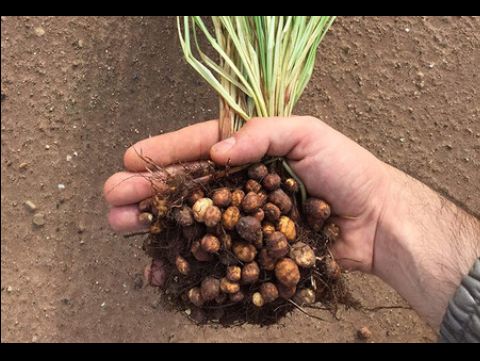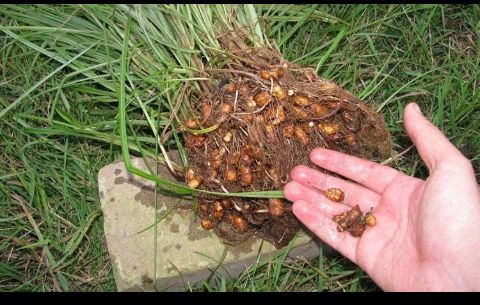Search Contents
How to Plant / Grow Tiger Nut
Tiger Nut is a sweet nut popularly sold by the Hausa peasant traders, in the market or and recently in the supermarket. Years back, it was the Hausa’s business only. They are pushed in the barrows around the streets of the cities and sold with other nuts like dates, kolanuts or bitter kola. In this post, we shall be discussing all you need to know about how to plant and grow Tiger nuts.
I am surprised why this seed is addressed as nuts while it is grown and harvested as tubers. Tiger nut is known in Nigeria as Aya in Hausa, Ofio in Yoruba or Aki Awusa or Imumu in Igbo language. Tiger nuts are a tasty, wholesome, and functional fruit. The plants produce large, sweet fruit that may be consumed fresh or prepared in a variety of ways. The tree is simple to cultivate, but it will need some attention if you want it to provide fruit all year round. You can enjoy this delectable treat for yourself by following the instructions in this article on how to plant and grow tiger nuts.
Tiger nut/ TigerNut

Tiger nuts are not written together, the ‘tiger’ and the ‘nut’ are written separately. The tiger nut grass like plants or leaves produces nuts called tiger nuts. It belongs to the same family as legumes, which also include peas, beans, and lentils. In addition to its native continents of Africa and Asia, the Tiger nut can also be found in Australia and southern Europe. How to Plant / Grow Tiger Nut
You’ll need extra time while cooking with them because their shell is harder than other nuts like almonds or peanuts because of their numerous layers (thus their name). This means that you can eat them while traveling (or anywhere with good cell reception) if you no longer have access to high-speed internet.
Are you among those who consume this sweet nut but don’t know its health benefits? Tiger Nuts are highly nutritious. In fact, the first day I went with my mother-in-law to the hospital for her eyes medical check-up, I noticed all the elderly patients were munching tiger nuts. When I asked them, they said doctors recommend it for them.
Health Benefits of Tiger Nuts
- A good source of protein is tigernuts.
- Tiger nuts are a great fiber source.
- Tigernuts include potassium, calcium, and magnesium in addition to vitamin C, which is necessary for the synthesis of collagen in the skin and connective tissue.
- Vitamin A supports strong bones, nerves, and eyesight, especially when it comes to night vision.
- It also hastens the recovery process after an injury or surgery by assisting your body in fighting infection more effectively than ever!
How to Plant / Grow Tiger Nut
- If you are farming on a large scale, such as one hectare, use a tractor to cultivate the land.
- Since the roots of this plant can reach depths of 30 to 60 cm, it is advisable to till the soil deeply to facilitate easy root penetration.
- Tiger nut plants can thrive in any type of soil, however for optimal performance, utilize sandy, moist, organic matter-rich soil.
- Tiger nuts can endure harsh conditions like heat, flooding, and drought.
- They need a soil PH between 5.0 and 7.0.
- They can’t stand saline soil or water, so don’t grow them in either. Manually sow the seeds 15–29 cm apart, 6–8 cm deep in the soil.
- The planting season runs from April through May when it is rainy.
- Both rhizomes and tubers can be used to plant. The portion of a plant that creeps along to the root is called a rhizome.
How to Plant / Grow Tiger Nut

- After the seedlings have sprouted for six weeks to two months, tubers begin to form (develop).
- After planting, four to five months later, they develop incredibly quickly (July- August).
- Three to four months pass before the nuts or tubers reach maturity.
- For planting, a hectare will need 120kg of tubers, whilst an acre will need 49kg.
- Wind can pollinate the plants that produce tiger nuts.
- You can grow them in containers by filling the container with a mixture of equal parts soil and manure. Put one seed in each container.
- Maintain a warm environment for them.
- Here, weeding and harvesting are simple processes.
- If you are going into commercial production, make sure you have a robust irrigation system in place for a steady supply of water. Tiger nuts demand appropriate water application.
- Additionally, as it is a root crop, it is best to avoid using too much nitrogenous fertilizer or manure after flowering.
Planting the Tiger Nut

Using a Pot to Plant Tiger nut
Plant fresh tiger nut seeds in a pot or on the ground. Plant seeds half an inch deep, then water them frequently until they sprout (usually within 3 weeks). After your seeds have germinated, trim back any vegetative growth so that just one or two branches appear at the tips of each branch. As these young plants grow taller than the capacity of their original containers, this will make it simpler for you to transplant them into larger pots. If you are growing Tiger nuts indoors under glass, you can also arrange them in rows outside!
Try putting tiger nut seeds outside straight at least once in the spring if your climate is warm enough for year-round growth outside (which it should be), so they’ll have time to establish themselves before the next winter arrives.
How to Plant / Grow Tiger Nut
Harvesting Tiger Nut
How do you know the tiger nuts are mature and ready for harvesting? The tiger nut will lose its green hue and turn brown when it is fully mature. The nut should be harvested when it has slightly dried out but is still full. Simply place the nuts in an airtight container and keep them in a cold, dry location to store them for later use.
They can be consumed raw or added to food as an ingredient. Because the nuts have a high-fat content and are difficult to digest once cooked, just shell them before storing them (1). Tiger nuts lose moisture via full drying during storage periods where no food preparation is done before eating them, so if you’re searching for methods to use them up, grinding them into flour might be something to think about!
Other Reasons You may Like to eat Tiger Nuts
- Tiger nuts can both improve your health and taste good.
- The nutrients in tiger nuts are excellent.
- They include a lot of protein and iron, which can help your bones and red blood cells stay strong.
- The fiber in tiger nuts makes you feel fuller for longer. This makes you less likely to overeat or eat unhealthy snacks between meals, which can cause you to gain weight.
Tiger nuts are also a good source of antioxidants that fight free radicals, manganese, a mineral that may help prevent cancer, and flavonoids, which are plant compounds that help prevent heart disease by lowering blood pressure. Tiger nuts are also high in vitamin A, which helps with vision development during pregnancy or breastfeeding.
A tropical tree that may be cultivated both inside and outside is the tiger nut tree. Antibacterial, anti-inflammatory, anti-coagulant, antioxidant, and antiviral characteristics are only a few of its numerous advantageous traits. Due to the tiger nut’s high antioxidant content, which may help prevent heart disease, it can be used in place of tea or coffee.
How to Plant / Grow Tiger Nut
Will Tiger Nut Grow in IgboLand or Eastern Nigeria?
Do Tiger Nuts grow on a Tree in the Ground?

How Does Tiger Nut Plant Look Like?
Tiger nuts do not grow on a tree. They are grown under the soil from grass or a plant, just like onions. See the photos of the grasses or the plants that grow tiger nuts.
See also our Popular Posts:
- 60 Latest Ankara Skirt and Blouse Styles for your Christmas Celebration
- White Net Cord Lace Styles for Ladies Reigning right Now
- 10 Photos Underage Pregnant Girls at Age 10 11 12 – Child Pregnancy
- What is the Meaning of Ameno Dorime Song? Is Dorime Ameno A Bad Song?
- How to Increase Transfer Limit on Access Bank Mobile App
- Latest Packing Gel HairStyles Reigning Right Now
- 120 Children Ankara Styles for 2022
- Latest Short Lace Gown Styles for Weddings and Party
How to Make Tiger Nuts Milk
Tiger nuts come in two varieties that are typically sold: dry tiger nuts and fresh tiger nuts. Kunu Aya is a typical creamy milk-like beverage with a spicy nutty flavor; once you drink it, you’ll become addicted. Tigernut beverage is sometimes referred to as “horchata de chufa” in Spain. You can use dry tiger nuts, fresh tigernuts, or a combination of the two to produce kunu aya. You must pre-soak the dry tigernuts before using them to help them regain moisture. Minerals such as calcium, iron, potassium, magnesium, and phosphorus are abundant in tigernuts. The vitamins E and C are also abundant in them.
Making kunun Aya, also known as “Horchata de Chufas” or Tigernuts Milk Drink. (This in Nigerian recipe)
Ingredients:
- 1 medium ginger,
- 10 dates (or fewer),
- 1 coconut,
- 2 cups of tiger nuts (I used a blend of fresh and dry tiger nuts)
How to Plant / Grow Tiger Nut
Step 1:
Soak the tiger nuts in clean water for at least overnight. If you use dry tiger nuts. You must soak them overnight to rehydrate and slightly expand them.
Step 2:
Rinse and put the soaked tiger nuts in a blender. Dates should be washed, with the seeds removed, and then put in the blender. Please keep in mind that dates are very sweet, so you don’t need to add sugar while using them.
Peel the coconut if using, and add the flesh to the mixer as well. Blend with a little water and the ginger that has been peeled.
Step 3:
Strain the milk into a basin using a cheesecloth or Pap cloth. The initial milk that is strained will be thick. Re-blend and filter the chaff and additional water in the blender until the full milk is extracted. The second strained batch of milk would be lighter than the first.
Avoid making the kunun aya overly light at any costs.
Step 4:
Put the milk beverage that was removed in a refrigerator to cool. Serve chilled.
How to Plant / Grow Tiger Nut
Due to its high concentration of arginine, which releases the hormone that creates insulin, and its content of carbohydrates with a basis of sucrose and starch (without glucose), sugar-free tiger nut milk is good for diabetics and also aids in weight control. Due to the fact that it contains digestive enzymes including amylase, catalase, and lipase, it is suggested for people who experience indigestion, gas, and diarrhea.
The high oleic acid content reduces cholesterol, avoiding thrombosis and heart attacks, and increasing blood levels of soluble glucose. Colon cancer risk is decreased by tiger nuts. This avoids constipation. Vitamin B1 is abundant in tiger nuts, which helps to balance the neurological system and promotes the body’s ability to adapt to stress.
Why You Should Drink Tiger Nut Milk
• The milk provides the body with an adequate amount of vitamin E, which is necessary for both male and female fertility. Additionally, vitamin E slows down cell aging, increases skin suppleness, and helps to reduce the appearance of wrinkles, acne, and other skin irregularities.
• Tiger nut milk is a potent aphrodisiac and is used in Ayurvedic medicine in China as a liver tonic, heart stimulant, and beverage to relieve severe stomach pain and encourage regular menstruation (sexual stimulant). The black kind of tiger nut is a highly effective treatment for breast cancer and lumps. The tubers’ high concentration of water-soluble flavonoid glycosides results in a comparatively high overall antioxidant capability.
Antioxidants could help populations that are malnourished by defending their immune systems. Consuming meals high in antioxidants may prevent HIV infection from developing into AIDS. The tiger nut tubers have long been thought to possess the necessary characteristics to treat several gastrointestinal ailments as well as respiratory infections.
According to local lore in Valencia, Spain, Tiger nuts are still regarded as a successful treatment for diarrhea. It encourages the flow of urine, which makes it a preventive measure for cysts, prostrates, hernias, rectum deformities, and prolapsed (anal feature: little, unpleasant flesh at the tip of the anus), as well as to avoid endometriosis or fibrosis and obstruction of the fallopian tube’s tip.



